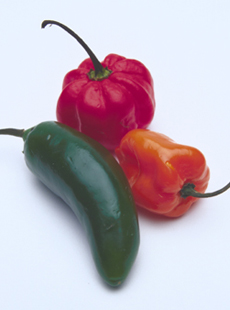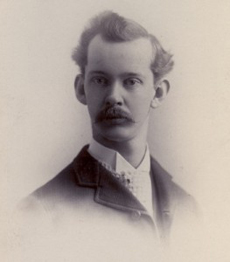Chile Pepper Glossary: A Glossary Of The Different Chile Pepper TypesPage 3: The Scoville Scale This is Page 3 of an 8-page article. Click on the red links below to visit other pages. This glossary is protected by copyright and cannot be reproduced in whole or part. You are welcome to link to it.
|
 Each variety of chile has a different level of heat. The Scoville Scale is the traditional method of measuring heat. Photo of green jalapeño, red Scotch bonnet and orange habanero chiles courtesy Ashley Foods. |
||||||||||||||||||||||||||||||||||||||||||||||||||||||||||
| The Scoville Scale
The most common way to evaluate chile pungency is a simple taste test. This method, although quick and cost-effective, may leave the tester in some pain: one would be happy to “let Mikey eat it.” There are two other ways of testing pungency as well, the Scoville organoleptic test and high performance liquid chromatography. In 1912, Wilbur Scoville (born Walter Lincoln Scoville, 1865-1942), a pharmacologist who worked for the large pharmaceutical manufacturer, Parke Davis (now a subsidiary of Pfizer), questioned how to determine the different heat levels of the wide variety of chiles. He developed the first systematic laboratory approach used to measure their pungency—a simple laboratory test.
|
 Wilbur Scoville. Photo courtesy Chile Foundry. |
||||||||||||||||||||||||||||||||||||||||||||||||||||||||||
|
Called the Scoville Organoleptic Test, human subjects taste a chile sample and evaluate how many parts of sugar water it takes to neutralize the heat of the chile so that its pungency is no longer noticeable. This dilution is called the Scoville Heat Unit. This procedure is more accurate than the taste test (“bite the chile”) technique and less expensive than more advanced laboratory techniques—although the measure of pungency is still subjective and depends on the taster’s palate and sensitivity to the capsaicin (the chemical compound that gives chiles their heat) that are responsible for pungency. (In addition, there are serious limits on how many samples a taster can handle within a reasonable time.) Today, a sophisticated laboratory process called High Performance Liquid Chromatography or HPLC, measures the amount of capsaicinoids (capsaicin) in parts per million. In this procedure, chile pods are dried, then ground; the capsaicins are extracted, and the extract is analyzed for total heat present as well as the individual capsaicinoids present. This method is more costly than the Scoville test or the taste test but much more accurate. While the measurement is in ASTA pungency units, not Scoville units, the scores are often converted to approximate Scoville unit values. The chart below rates chiles, with 0 being mildest and 10 highest heat.
Most chart data from The Pepper Encyclopedia by Dave De Witt, William Morrow & Company. *Guinness Book of Records’ “hottest spice”: In February 2007, the bhut jolokia from India was named the world’s hottest. A naturally occurring chile hybrid native to the Assam region of northeastern India, Bhut jolokia means “Ghost Chile” in Assamese. Prior to this new designation, the Red Savina was considered the world’s hottest; then in April 2007 the Dorset Naga tested almost 60% higher 876,000 SHUs. Originating in Bangladesh, it is sold with a health warning. Continue To Page 4: Chile Glossary A To B
|
|||||||||||||||||||||||||||||||||||||||||||||||||||||||||||
Last Updated May 2018
© Copyright 2005-2025 Lifestyle Direct, Inc. All rights reserved. All images are copyrighted to their respective owners.